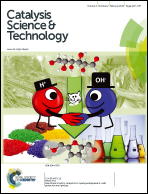Influence of CeO2 modification on the properties of Fe2O3–Ti0.5Sn0.5O2 catalyst for NO reduction by CO†
Abstract
Fe2O3–CeO2–Ti0.5Sn0.5O2 catalysts were prepared by a wet impregnation method and were characterized using XRD, LRS, EPR, H2-TPR, in situ IR, as well as the activity test for the removal of NO by CO. The results showed that the Fe2O3 and CeO2 are highly dispersed on the surface of Ti0.5Sn0.5O2 (the loading of Fe2O3 and CeO2 are 1.2 mmol Fe per 100 m2 and 0.4 mmol Ce per 100 m2, respectively). When the iron oxide loading is increased, the isolated Fe3+ ions change into the polymeric Fe3+ clusters and ceria addition also further promotes the formation of polymeric Fe3+ clusters. Catalysts modified with ceria display better performance in activity, and this would result from the formation of the more polymeric Fe3+ clusters, which are more easily reduced to Fe2+ ions under CO atmosphere. In situ FT-IR results indicated that the Fe2+ ions generated from the reduction of Fe3+ ions are primary active sites for NO + CO reactions. A possible reaction mechanism is tentatively proposed. In the reaction atmosphere, NO adsorbed on the surface of the catalysts forms several types of nitrite species. With the increase of temperature, bridging bidentate nitrate species transform into chelating nitro species, which react with CO gas to produce CO2 + N2O. When temperature reaches beyond 200 °C, NO adsorbed on Fe2+ ions (reduction of Fe3+ ions) reacts with carbonate species adsorbed on the surface of the catalysts, and produces CO2 + N2.


 Please wait while we load your content...
Please wait while we load your content...